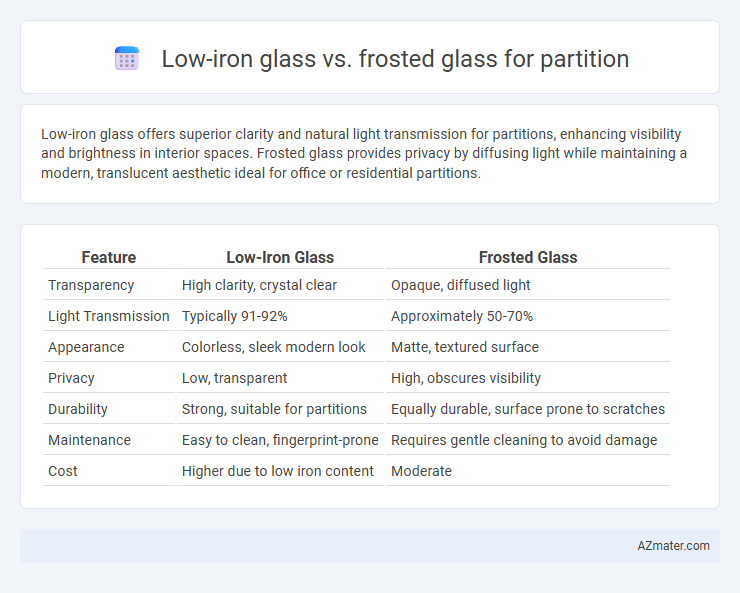Low-iron glass offers superior clarity and natural light transmission for partitions, enhancing visibility and brightness in interior spaces. Frosted glass provides privacy by diffusing light while maintaining a modern, translucent aesthetic ideal for office or residential partitions.
Table of Comparison
| Feature | Low-Iron Glass | Frosted Glass |
|---|---|---|
| Transparency | High clarity, crystal clear | Opaque, diffused light |
| Light Transmission | Typically 91-92% | Approximately 50-70% |
| Appearance | Colorless, sleek modern look | Matte, textured surface |
| Privacy | Low, transparent | High, obscures visibility |
| Durability | Strong, suitable for partitions | Equally durable, surface prone to scratches |
| Maintenance | Easy to clean, fingerprint-prone | Requires gentle cleaning to avoid damage |
| Cost | Higher due to low iron content | Moderate |
Introduction to Glass Partitions
Low-iron glass offers high clarity and brightness, making it ideal for partition walls that require maximum transparency and natural light flow. Frosted glass provides privacy by diffusing light while maintaining an elegant, modern appearance often used in office or bathroom partitions. Choosing between low-iron and frosted glass depends on the desired balance between visibility and privacy in interior space design.
What is Low-Iron Glass?
Low-iron glass is a high-clarity glass with reduced iron content, resulting in minimal green tint and enhanced light transmission, ideal for partitions requiring a crystal-clear appearance. Compared to frosted glass, which diffuses light and obscures visibility for privacy, low-iron glass offers superior transparency and a sleek, modern aesthetic. Its purity and color accuracy make it a preferred choice for architectural applications where clarity and brightness are essential.
What is Frosted Glass?
Frosted glass is a type of glass treated with acid or sandblasting to create a translucent, matte finish that diffuses light and provides privacy while allowing natural light to pass through. In contrast to low-iron glass, which offers greater clarity and reduced green tint for enhanced visibility, frosted glass prioritizes obscurity and aesthetic texture for partitions. This makes frosted glass ideal for spaces requiring privacy without sacrificing brightness, such as office cubicles and bathroom partitions.
Visual Clarity: Low-Iron vs Frosted Glass
Low-iron glass offers superior visual clarity compared to frosted glass, providing a crystal-clear, transparent view ideal for partitions where unobstructed sightlines are essential. Frosted glass diffuses light and obscures visibility, delivering privacy but reducing detail and sharpness. Choosing low-iron glass enhances natural light transmission and maintains true color rendering, making it preferable for visually open, bright partition designs.
Light Transmission and Privacy Comparison
Low-iron glass offers superior light transmission, often exceeding 90%, making it ideal for partitions where maximizing natural light is essential. Frosted glass, with light transmission ranging from 40% to 70%, enhances privacy by diffusing light and obscuring visibility while still allowing ambient illumination. Choosing between low-iron and frosted glass depends on balancing the need for clear, bright spaces against the requirement for visual privacy in partition applications.
Aesthetic Differences in Interior Design
Low-iron glass offers a crystal-clear, highly transparent appearance that enhances natural light and provides a modern, minimalist aesthetic in interior design. Frosted glass features a translucent, matte finish that diffuses light softly, creating privacy while adding a subtle texture and warmth to partitions. Choosing between the two depends on the desired balance between clarity and privacy, with low-iron glass favored for sleek openness and frosted glass for privacy-oriented, cozy environments.
Durability and Maintenance
Low-iron glass offers superior durability due to its enhanced clarity and resistance to discoloration, making it ideal for long-lasting partitions that maintain a pristine appearance over time. Frosted glass, while providing privacy and aesthetic appeal, tends to show scratches and dirt more readily, requiring frequent cleaning and careful maintenance to preserve its finish. Choosing low-iron glass ensures lower upkeep and prolonged structural integrity, whereas frosted glass demands more cautious handling to avoid wear and tear.
Applications in Commercial and Residential Spaces
Low-iron glass offers superior clarity and transparency, making it ideal for commercial spaces such as offices and retail stores where maximizing natural light and visual openness is essential. Frosted glass provides privacy while allowing diffused light, commonly used in both residential bathrooms and conference rooms where subtle separation without complete blockage is needed. Choosing between low-iron and frosted glass depends on balancing visibility and privacy requirements in specific commercial and residential partition applications.
Cost Considerations: Which is More Affordable?
Low-iron glass typically costs more than frosted glass due to its higher purity and enhanced clarity, making it a premium choice for partitions requiring transparency and minimal green tint. Frosted glass is generally more affordable, created by acid etching or sandblasting regular glass, which adds privacy at a lower price point. For budget-conscious projects prioritizing privacy over clarity, frosted glass offers a cost-effective solution without sacrificing aesthetic appeal.
Choosing the Right Glass for Your Partition Needs
Low-iron glass offers higher clarity and a more transparent look ideal for partitions where natural light and visibility are priorities, providing a sleek, modern aesthetic. Frosted glass enhances privacy by diffusing light and obscuring visibility, making it perfect for partitions in offices or bathrooms where discretion is important. When choosing the right glass for your partition, consider the balance between transparency, privacy, and the desired visual effect to match your functional and design requirements.

Infographic: Low-iron glass vs Frosted glass for Partition
 azmater.com
azmater.com